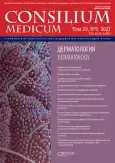Evaluation of the sexual and age structure of infestation by the Demodex mite and percentage of complications of acne-related dermatoses with secondary demodicosis, depending on their severity
- Authors: Zhiltsova E.E.1,2, Politov S.A.1,2, Bakovetskaya O.V.1, Kochetkova D.L.1, Egorova E.A.1
-
Affiliations:
- Pavlov Ryazan State Medical University
- Ryazan Regional Clinical Dermatovenerologic Dispensary
- Issue: Vol 23, No 8 (2021)
- Pages: 633-636
- Section: Articles
- URL: https://journal-vniispk.ru/2075-1753/article/view/97100
- DOI: https://doi.org/10.26442/20751753.2021.8.201182
- ID: 97100
Cite item
Full Text
Abstract
Background. The article provides a detailed review of the etiopathogenetic, clinical and diagnostic aspects of demodectic skin of the face, considers the modern classification of this pathological condition, provides statistical data on the sex and age structure of population invasion by a tick of the genus Demodex, as well as the percentage of complications with secondary demodicosis of acneform dermatoses (rosacea and perioral dermatitis).
Aim. To reveal the percentage of complications of the course of acneform dermatoses (perioral dermatitis and rosacea) with demodicosis, depending on the severity of the underlying disease, as well as the sex and age structure of the invasion among the patients of the study group.
Materials and methods. In our own study, we assessed the sex and age structure of the Demodex mite infestation and the percentage of complications of rosacea and perioral dermatitis with secondary demodicosis, depending on their severity. The severity of clinical manifestations of rosacea was assessed using the rosacea diagnostic assessment scale; the PODSI index was used for perioral dermatitis. Before the start of the course of therapy and after its completion, all patients underwent a microscopic examination of scrapings from the skin of the face in order to detect a diagnostically significant number of individuals of the Demodex genus tick (5 or more). If a tick was found in scrapings, along with standard therapy drugs, patients were locally prescribed 1% ivermectin cream once a day for a course of 2 to 4 months, depending on the severity of the clinical manifestations of dermatosis.
Results. It was found that the incidence of Demodex invasion in the study group increased in direct proportion to the severity of the clinical manifestations of dermatoses and the age of the patients. It was also found that among the patients of the study group, demodicosis was registered in women almost twice as often as in men. Topical use of 1% ivermectin cream has shown a high profile of the efficacy and safety of this drug.
Conclusion. After the completing the treatment course, complete elimination of Demodex, confirmed by laboratory, was achieved in 100% of patients with demodicosis in the study group. There were no adverse events or side effects while taking the drug.
Keywords
Full Text
##article.viewOnOriginalSite##About the authors
Elena E. Zhiltsova
Pavlov Ryazan State Medical University; Ryazan Regional Clinical Dermatovenerologic Dispensary
Email: elen_egorovna@mail.ru
ORCID iD: 0000-0001-9406-6841
D. Sci. (Med.), Assoc. Prof.
Russian Federation, Ryazan; RyazanSergey A. Politov
Pavlov Ryazan State Medical University; Ryazan Regional Clinical Dermatovenerologic Dispensary
Author for correspondence.
Email: sergeipolitov95@mail.ru
ORCID iD: 0000-0001-6111-6128
Аssistant
Russian Federation, Ryazan; RyazanOlga V. Bakovetskaya
Pavlov Ryazan State Medical University
Email: sergeipolitov95@mail.ru
ORCID iD: 0000-0002-8102-4463
D. Sci. (Med.), Prof.
Russian Federation, RyazanDarya L. Kochetkova
Pavlov Ryazan State Medical University
Email: sergeipolitov95@mail.ru
ORCID iD: 0000-0001-5705-2424
Student
Russian Federation, RyazanEvgeniia A. Egorova
Pavlov Ryazan State Medical University
Email: sergeipolitov95@mail.ru
ORCID iD: 0000-0001-9642-2272
Resident
Russian Federation, RyazanReferences
- Кубанов А.А., Галлямова Ю.А., Гревцева А.С. Демодекоз. Лечащий врач. 2014;11:7 [Kubanov AA, Galljamova JA, Grevtseva AS. Demodecosis. Lechaschi Vrach Journal. 2014;11:7 (in Russian)].
- Елистратова Л.Л., Потатуркина-Нестерова Н.И., Нестеров А.С. Современное состояние проблемы демодекоза. Фундаментальные исследования. 2011;9-1:67-9 [Elistratova LL, Potaturkina-Nesterova NI, Nesterov AS. Sovremennoe sostoyanie problemy demodekoza. Fundamental'nye issledovaniya. 2011;9-1:67-9 (in Russian)].
- Сирмайс Н.С., Абесадзе Г.А., Устинов М.В. Демодекоз: патогенетические аспекты при различных дерматозах лица. Методическое пособие. М., 2013 [Sirmais NS, Abesadze GA, Ustinov MV. Demodecosis: pathogenetic aspects in various dermatoses of the face. Toolkit. Moscow, 2013 (in Russian)].
- Lacey N, Kavanagh K, Tseng SC. Under the lash: Demodex mites in human diseases. Biochem (Lond). 2009;31:2-6.
- Hom MM, Mastrota KM, Schachter SE. Demodex. Optom Vis Sci. 2013;90(7):198-205.
- Данилова А.А., Федоров С.М. Паразитарные болезни кожи. Русский медицинский журнал. 2000;8(6):249-54 [Danilova AA, Fedorov SM. Parazitarnye bolezni kozhi. Russkii meditsinskii zhurnal. 2000;8(6):249-54 (in Russian)].
- Krader CG. Novel device characterizes mite infestations. Dermatology Times. 2020;41(11).
- Chen W, Plewig G. Human Demodicosis: Revisit and a Proposed Classification. Br J Dermatol. 2014;170(6):1219-25. doi: 10.1111/bjd.12850
- O’Reilly N, Bergin D, Reeves EP, et al. Demodex-associated bacterial proteins induce neutrophil activation. Br J Dermatol. 2012;166:753-60. doi: 10.1111/j.1365-2133.2011.10746.x
- Li J, O’Reilly N, Sheha H, et al. Correlation between ocular Demodex infestation and serum immunoreactivity to Bacillus proteins in patients with Facial rosacea. Ophthalmology. 2010;117:870-7. doi: 10.1016/j.ophtha.2009.09.057
- Жильцова Е.Е., Межевая К.В., Исаков С.А. Современные аспекты распространенности и клиники розацеа. Лечащий врач. 2019;9:80-2 [Zhiltsova EE, Mezhevaya KV, Isakov SA. Modern aspects of the prevalence and clinical picture of rosacea. Lechaschi Vrach Journal. 2019;9:80-2 (in Russian)]. doi: 10.26295/OS.2019.45.15.017
- Позднякова М.А., Красильникова О.Н., Жильцова Е.Е. Медико-социальные и юридические аспекты косметологической помощи. Наука молодых. 2017;4:509-19 [Pozdniakova MA, Krasilnikova ON, Zhiltsova EE. Medico-social and legal aspects of medical care in cosmetology. Eruditio Juvenium. 2017;4:509-19 (in Russian)]. doi: 10.23888/HMJ20174509-519
- Юцковская Я.А., Кусая Н.В., Ключник С.Б. Обоснование патогенетической терапии при акнеподобных дерматозах, осложненных клещевой инвазией Demodex folliculorum. Клиническая дерматология и венерология. 2010;3:60-3 [Yutskovskaya YaA, Kusaya NV, Klyuchnik SB. Obosnovanie patogeneticheskoy terapii pri aknepodobnykh dermatozakh, oslozhnennykh kleshchevoy invaziey Demodex folliculorum. Klinicheskaya dermatologiya i venerologiya. 2010;3:60-3 (in Russian)].








